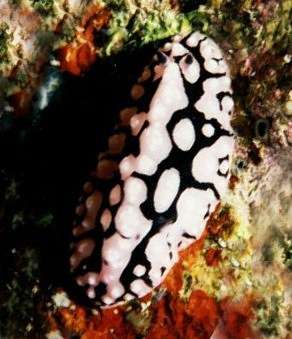
Phyllidiopsis sinaiensis
(Yonow, 1988)
Order: NUDIBRANCHIA
Suborder: DORIDINA
Family: Phyllidiidae
DISTRIBUTION
The unique holotype was collected from the "Amphora site", Gulf of Aqaba in the Red Sea.
PHOTO
Red Sea, Egypt, "Elphinestone Reef, Length 1 cm, Depth 10 m, October 21 1997. PHOTO: Erwin Koehler. See message below.
Brunckhorst, (1993) did not have access to photos of the living colour and pattern of this species.
He notes: "It is probably black and pink (as observed for other Phyllidiopsis species with bicoloured rhinophores)". He also incorrectly describes the rhinophores as pink apically and black basally. Yonow (1988) described this species as having white tubercles on a black background, bicoloured rhinophores and lacking markings on the foot sole, but did not dissect the specimen. The anatomy of the holotype clearly places it in the genus Phyllidiopsis.
Principal distinguishing characters of P. sinaiensis include the tuberculate central ridge, large and multicompound, broad based, pink tubercles (the low tubercles of the holotype are artifacts), and bicoloured rhinophores, black apically and pink basally, with a black band running to the base in the posterior midline. In some specimens, the bases of the tubercles may fuse, leading to a predominately pink dorsum with only a few black lines.
-
Brunckhorst, D.J. (1993) The systematics and phylogeny of Phyllidiid Nudibranchs (Doridoidea). Records of the Australian Museum, Supplement 16: 1-107.
-
Farhner, A. & Schroedl, M. 2000. Redescription of Phyllidiopsis sinaiensis (Yonow, 1988), with review of Red Sea Phyllidiidae. Journal of Molluscan Studies, 66: 467-476.
See Farhner & Schroedl's message below.
Authorship detailsRudman, W.B., 1999 (August 4) Phyllidiopsis sinaiensis (Yonow, 1988). [In] Sea Slug Forum. Australian Museum, Sydney. Available from http://www.seaslugforum.net/find/phylsina
Related messages
Red Sea Phyllidiopsis
December 30, 2004
From: Binyamin Koretz
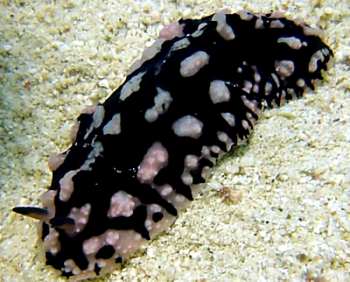
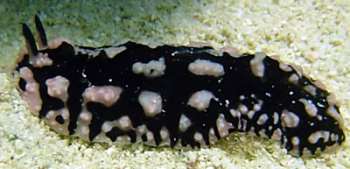
Hi Bill,
Could this be Phyllidiopsis sinaiensis? It has the bicolored rhinophores but far more black (including the central ridge) than the other specimens we've seen for this species. It being Eilat, there's not a lot of other possibilities.
Locality: Coral Beach Nature Reserve, Eilat, Israel. Red Sea
Depth: 10m. Length: 8 cm. June 2003
mixed sand and coral pinnacles
Photographer: Binyamin and Shulamit Koretz
thanks
Binyamin Koretz
binyamin@koretz.net
Koretz, B., 2004 (Dec 30) Red Sea Phyllidiopsis. [Message in] Sea Slug Forum. Australian Museum, Sydney. Available from http://www.seaslugforum.net/find/12848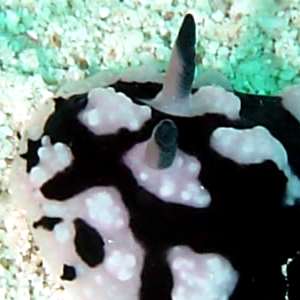
Dear Binyamin,
I am pretty sure you are correct in thinking this is Phyllidiopsis sinaiensis. As with most nudibranchs, we don't know a lot about colour variation in this species, but it seems most likely that this is an animal with an overabundance of the black pigmentation.
Perhaps Michael Schroedl, who has first hand knowledge on this species will be able to give us his views?
Best wishes,
Bill Rudman
On the holotype of Phyllidiopsis sinaiensis
September 9, 2003
From: Michael Schroedl
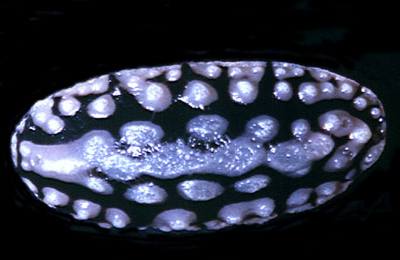
Hi Bill,
This is a contribution to the discussion on Phyllidiopsis sinaiensis.
I was quite surprised to see Bernard’s photograph of the “holotype” of P. sinaiensis. Redescribing that species, Alexander Fahrner and I re-examined a specimen from the British Museum of Natural History that was labelled as being the holotype of P. sinaiensis (BMNH 1986.231; see photograph) that clearly differs from that shown on Bernard’s photograph. The museum specimen refers to the original description of a single specimen by Yonow (1988) and to its redescription by Brunckhorst (1993). Thus, the specimen from the BMNH is the holotype of P. sinaiensis and Bernard’s photograph must have been somehow confused. Bernard’s specimen resembles Phyllidiella pustulosa due to tubercle pattern and black rhinophores. The principal distinguishing features of P. sinaiensis are as described by Fahrner & Schrödl (2000), including the central tubercle ridge, more or less large and multicompound, broad based, pink tubercles, bicoloured rhinophores with a black tip and the stalk black posteriorly and pink anteriorly, well developped rhinotubercles, the very elongate muscular oesophageal segment, the distinct stomach and the extremely long, convoluted prostate that is bound together by connective tissue. In some specimens, the bases of the tubercles may fuse leading to a predominantely pink dorsum with only a few black lines. The preserved holotype was described to show low and not compound dorsal tubercles by Yonow (1988) and Brunckhorst (1993) but this can be easily explained by the artificial abrasion of all central notum tubercles of the holotype (see Fahrner & Schrödl, 2000).
All specimens currently posted under P. sinaiensis but Bernard’s “holotype” appear to be true P. sinaiensis. In addition, the specimen from Jordan, Aqaba, of Erwin Köhler currently identified as Phyllidiopsis krempfi is certainly P. sinaiensis. Other P. krempfi apparently do not show a distinct tubercle ridge as characteristic for P. sinaiensis. Anyway, some P. krempfi at least externally may look quite similar to P. sinaiensis, and it may be tested by anatomical or molecular means whether or not P. sinaiensis is a Red Sea relative of the Indo-Pacific P. krempfi in the future.
• BRUNCKHORST, D.J. 1993. The Systematics and Phylogeny of Phyllidiid Nudibranchs (Doridoidea). Records of the Australian Museum, Supplement 16: 1-107.
• FAHRNER, A. & SCHRÖDL, M. 2000. Redescription of Phyllidiopsis sinaiensis (Yonow, 1988) (Nudibranchia: Doridoidea: Phyllidiidae), with a review of the Red Sea Phyllidiidae. Journal of Molluscan Studies, 66: 467-476.
• YONOW, N. 1988. Red Sea Opisthobranchia 1: The family Phyllidiidae (Mollusca: Nudibranchia). Fauna of Saudi Arabia, 9: 138-151.
Cheers,
Michael
schroedl@zi.biologie.uni-muenchen.de
Schroedl , M., 2003 (Sep 9) On the holotype of Phyllidiopsis sinaiensis. [Message in] Sea Slug Forum. Australian Museum, Sydney. Available from http://www.seaslugforum.net/find/10101Thanks Michael,
Nothing is ever simple with these phyllidiids. I am posting a message from Bernard Picton on this very topic which he sent some time before yours. As I mention there, both messages have been waiting in the 'pending' queue too long. Fortunately Jukka-Pekka's photos were the catalyst to post them as well. It is intersting that both you and Bernard suspect we may need to do some molecular studies to sort this group out
Best wishes,
Bill Rudman
Phyllidiopsis sinaiensis from Red Sea?
September 9, 2003
From: Jukka-Pekka Salmenkaita
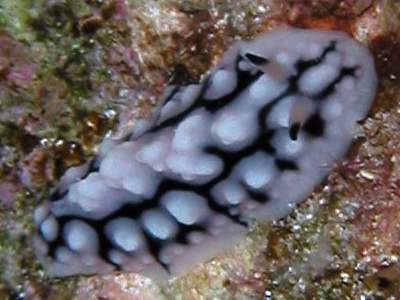
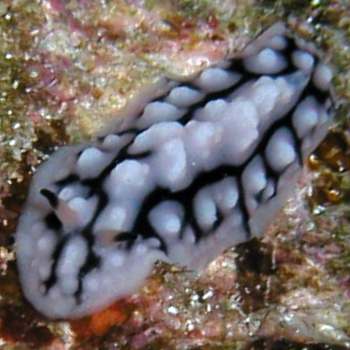
Dear Bill,
This specimen is from Jackson reef, Strait of Tiran, Red Sea; photographed in April 9th, 2003. Length some 25 mm, depth around 8 meters. Is it Phyllidiopsis sinaiensis ?
Best regards,
Jukka-Pekka
jsalmenk@cc.hut.fi
Salmenkaita, J-P., 2003 (Sep 9) Phyllidiopsis sinaiensis from Red Sea?. [Message in] Sea Slug Forum. Australian Museum, Sydney. Available from http://www.seaslugforum.net/find/10621Dear Jukka-Pekka,
This certainly looks like Phyllidiopsis sinaiensis. Your photo shows the rhinophores particularly well and the basal region has a distinct pinkish tinge
Best wishes,
Bill Rudman
Holotype of Phyllidiopsis sinaiensis - correction
September 9, 2003
From: Bernard Picton
Hi Bill,
I think I've made a bad mistake over Phyllidiopsis sinaiensis. The photo I sent which I thought was of the holotype is a good match for the one Nathalie Yonow herself identified for Erwin Koehler, but I've now taken another look at Nathalie's original description and I'm sure neither of these is actually what she described as P. sinaiensis. She had a single specimen (collected by myself) and illustrates this in a drawing - it does match perfectly with the photo sent to you by A. Fahrner & M. Schroedl on May 23rd 2001. (Part of this confusion has arisen because I sent you the one I thought was the P. sinaiensis holotype in Feb 2001, before I checked Nathalie's paper and I was looking at Erwin's photo as my reference. I should have known to check the original source I know!!).
On the other hand I think there are then virtually no differences between P. sinaiensis and P. krempfi, if as Alexander and Michael point out, the tubercles are compound not 'single structures' as Nathalie described them from the preserved specimen. I'd keep the name for Red Sea ones though, as taking a splitter approach at least helps gather separate data sets. We need population samples and growth series from every locality I guess.
These Phyllidiids are really a nightmare! I'm sure they must be prime candidates for some DNA or protein electrophoresis work and I doubt we'll get it right until that is done. Given how much visual selection must be
going on to produce mimics like Aldisa williamsi and the flatworms you have on your Phyllidiella mimicry page I'm not surprised that humans have a problem with them.
Bernard
bernard.picton.um@nics.gov.uk
Picton, B.E., 2003 (Sep 9) Holotype of Phyllidiopsis sinaiensis - correction. [Message in] Sea Slug Forum. Australian Museum, Sydney. Available from http://www.seaslugforum.net/find/10929Thanks Bernard,
THis message of yours has been sitting in the 'pending' file for some time with a separate message from Michael Schroedl on the same topic. The reason for the delay in posting these is that I was trying to find time to check these phyllidiids myself, but as you say they are very confusing and my time for 'reflection', rather than just 'reaction' seems to be getting shorter and shorter. What I am not clear about is the identity of the animal you thought was the holotype?
Best wishes,
Bill Rudman
Phyllidiella pustulosa from Egypt (2)
March 8, 2003
From: Marina Poddubetskaia
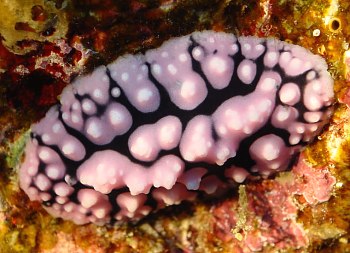
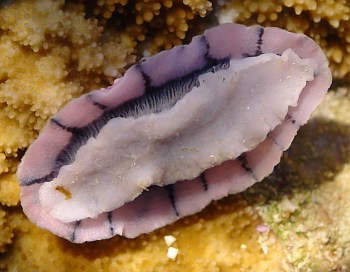
Dear Bill,
To accompany my other message here are photos of the other animal I think is P. pustulosa.
Date: February 09, 2003
Location: Safaga, Egypt, Red Sea
Site: Panorama Reef
Depth: 8m. Size: 60-65mm
Photos: Marina Poddubetskaia - Nembro website
Best wishes,
Marina.
nembro@nembro.info
Poddubetskaia, M., 2003 (Mar 8) Phyllidiella pustulosa from Egypt (2). [Message in] Sea Slug Forum. Australian Museum, Sydney. Available from http://www.seaslugforum.net/find/9247Dear Marina,
If anyone out there would like to take responsibility for making sense of these Indian Ocean phyllidiids I would be very grateful. I don't think this is Phyllidiella pustulosa. It has similarities to Phyllidiopsis sinaiensis but from the messages on that page no one seems very sure just what that specis is either.
Best wishes,
Bill Rudman
Phyllidiopsis krempfi? from Jordan
December 16, 2002
From: Erwin Köhler
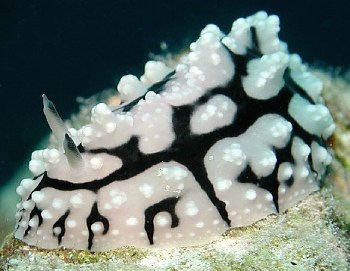
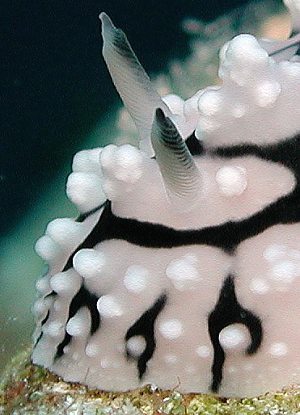
Dear Bill,
Attached are 2 pictures of Phyllidiopsis krempfi(?). I photographed it at Jordan, Aqaba, divesite "First Bay" on 13 November 2002.
It's size was 48mm, the depth 17m.
I think the close-up of the head shows the structure of the rhinopores pretty well.
Erwin
Erwin@medslugs.de
Köhler, E., 2002 (Dec 16) Phyllidiopsis krempfi? from Jordan. [Message in] Sea Slug Forum. Australian Museum, Sydney. Available from http://www.seaslugforum.net/find/8557Note added 9 Sept 2003: This is P. sinaiensis - see M. Schroedl's message.
Dear Erwin,
I would agree that this is most probably Phyllidiopsis krempfi. Even it turns out to be something else, I must agree that you've done an excellent job with the rhinophore photo
Cheers,
Bill Rudman
Phyllidiopsis sinaiensis from Egypt
September 28, 2002
From: Michael Mrutzek
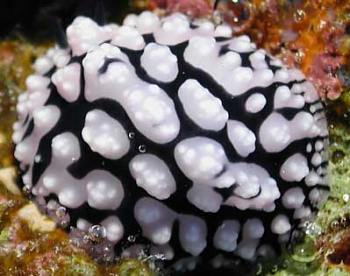
Dear Bill,
Here is a photo of another slug from the Red Sea for use in the Forum.
Data:
Erg abu Ramada, 25meters, off Hurghada, Red Sea coast of Egypt, August, 2002. Photo: Copyright Michael Mrutzek.
Michael
Mrutzek@meeresaquaristik.de
Mrutzek, M., 2002 (Sep 28) Phyllidiopsis sinaiensis from Egypt. [Message in] Sea Slug Forum. Australian Museum, Sydney. Available from http://www.seaslugforum.net/find/8037Dear Michael,
I think this is Phyllidiopsis sinaiensis, but some of these species are difficult to identify from photos, so I may be wrong.
Best wishes,
Bill Rudman
Phyllidiopsis sinaiensis Holotype
May 23, 2002
From: Bernard Picton
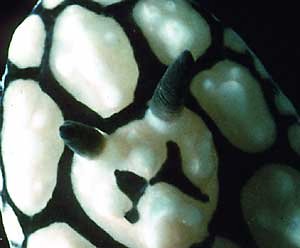
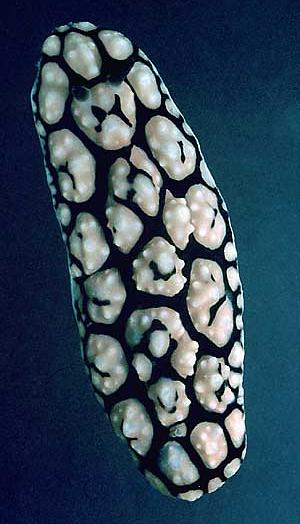
Note added 9 Sept 2003: See messages from Bernard Picton and Michael Schroedl showing that this is not the holotype of P. sinaiensis and is possibly a specimen of Phyllidiella pustulosa.
Dear Bill,
I just found the box of slides of Red Sea Phyllidiids I sent to Nathalie Yonow which includes pictures of Phyllidiopsis sinaiensis - the specimen which was later designated as the holotype. I've sent 2 scans here. NB. you (quoting Brunckhorst) describe the rhinophores as black basally and pale apically - actually they are black at the tip and pale at the base (as in other species with bicoloured rhinophores).
Nathalie describes them thus:
'the tip is black and this extends proximally down the posterior side, so that at the base the rhinophore is mostly gray with a posterior black line'.
I can't see this in any of my pictures but that may be because of the angle, it is a good description of the rhinophores in P. krempfi however!
Bernard
bernard.picton.um@nics.gov.uk
Picton, B., 2002 (May 23) Phyllidiopsis sinaiensis Holotype. [Message in] Sea Slug Forum. Australian Museum, Sydney. Available from http://www.seaslugforum.net/find/6445Thanks Bernard,
I must say I hadn't noticed Brunckhorst's slip with the rhinophore colours. The rhinophore colours are fairly critical in this group and it appears that Yonow was also confused. Your photo of the holotype and Erwin Koehler's photo suggest that the upper half of the rhinophoore club is black and the base is white or colourless. There is no sign of the black posterior line that she mentions. Perhaps she had specimens of P. krempfi mixed up in the material she was using. From your accompanying message it seems the two species are easy to confuse.
Best wishes,
Bill Rudman
Farhner & Schroedl's Phyllidiopsis sinaiensis
May 23, 2002
From: Bernard Picton
Dear Bill,
I just looked at Farhner & Schroedl's paper redescribing Phyllidiopsis sinaiensis after sending you a scan of the holotype. In my opinion they clearly have Phyllidiopsis krempfi not P. sinaiensis, the pictures in their paper are identical to the P. krempfi I have seen in East Africa [see separate message].
• Farhner, A. & Schroedl, M. 2000. Redescription of Phyllidiopsis sinaiensis (Yonow, 1988), with review of Red Sea Phyllidiidae. Journal of Molluscan Studies, 66: 467-476.
Cheers,
Bernard
bernard.picton.um@nics.gov.uk
Picton, B., 2002 (May 23) Farhner & Schroedl's Phyllidiopsis sinaiensis. [Message in] Sea Slug Forum. Australian Museum, Sydney. Available from http://www.seaslugforum.net/find/6451Dear Bernard,
Thanks for drawing this to our attention.
Your photo of the holotype certainly shows that it has important differences when compared with Farhner & Schroedl's description, which can be see in the photos they have sent to the Forum. The most significant one is the colour of the rhinophores, which in their animal forms a distinct black line down the posterior midline, just as in P. krempfi. Interestingly, Erwin Koehler has two sets of photos on the Forum identified as P. sinaiensis from the Egyptian Red Sea. One of these, [1997 photo] was identified by Nathalie Yonow as P. sinaiensis and like your photo does not show a black posterior midline, while a more recent 2002 photo is of an animal in which the black posterior line on the rhinophore is clearly visible. On reconsideration I would suspect this photo is also P. krempfi.
Any comments welcome,
Cheers,
Bill Rudman
Phyllidiopsis sinaiensis? from Egypt
January 14, 2002
From: Erwin Köhler
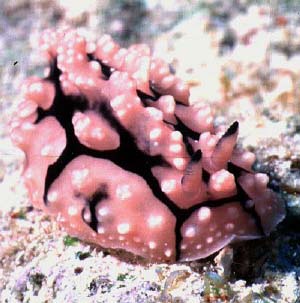
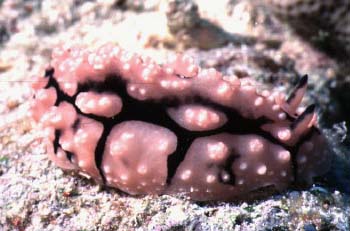
Dear Bill,
A happy new year to you.
Here is the first one of my recent trip to Egypt. Is it Phyllidiopsis sinaiensis?
Data: 44mm, depth 16m, Egypt, Hamata, Red Sea. divesite "Shaab Claudio", 4th January 2002
Erwin
Erwin@medslugs.de
Köhler, E., 2002 (Jan 14) Phyllidiopsis sinaiensis? from Egypt. [Message in] Sea Slug Forum. Australian Museum, Sydney. Available from http://www.seaslugforum.net/find/5955Dear Erwin,
I guess Egypt was a warmer way to start the New Year than staying in Germany. Yes this is Phyllidiopsis sinaiensis.
Best wishes,
Bill Rudman
Phyllidiopsis sinaiensis in the Red Sea
May 23, 2001
From: A. Farhner & M. Schroedl
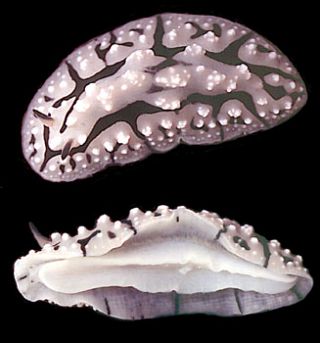
Hi Bill,
We found that Phyllidiopsis sinaiensis is one of the most common nudibranchs in the Gulf of Aqaba, northern Red Sea. The fact that it has been so rarely reported since its original collection in 1980 can be explained by being confused with the externally similar, well-known species Phyllidiella pustulosa (Cuvier, 1804).
Principal distinguishing characters of P. sinaiensis include the central tubercle ridge, large and multicompound, broad based, pink tubercles (the low tubercles of the holotype are artifacts), and bicoloured black and pink rhinophores. In some specimens, the bases of the tubercles may fuse, leading to a predominantely pink dorsum with only a few black lines.
Reference:
Farhner, A. & Schroedl, M. 2000. Redescription of Phyllidiopsis sinaiensis (Yonow, 1988), with review of Red Sea Phyllidiidae. Journal of Molluscan Studies, 66: 467-476.
Best wishes,
Alexander and Michael
schroedl@zi.biologie.uni-muenchen.de
Farhner, A. & Schroedl, M., 2001 (May 23) Phyllidiopsis sinaiensis in the Red Sea. [Message in] Sea Slug Forum. Australian Museum, Sydney. Available from http://www.seaslugforum.net/find/4323Dear Alexander and Michael,
Thanks for your continuing contributions to the Forum. They are much appreciated
Best wishes,
Bill Rudman
Photo of Phyllidiopsis sinaiensis
August 4, 1999
From: Erwin Koehler

Bill,
Here is one Phyllidiopsis sinaiensis, identified by Nathalie Yonow.
Red Sea, Egypt, "Elphinestone Reef", size 1 cm, depth 10 m, date October 21 1997
Erwin
Medslugs.Koehler@t-online.de
Koehler, E., 1999 (Aug 4) Photo of Phyllidiopsis sinaiensis. [Message in] Sea Slug Forum. Australian Museum, Sydney. Available from http://www.seaslugforum.net/find/1147Thanks Erwin,
It makes the Phyllidiopsis story as complete as we know it at present.
Bill Rudman.
